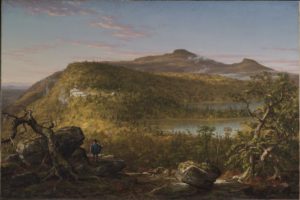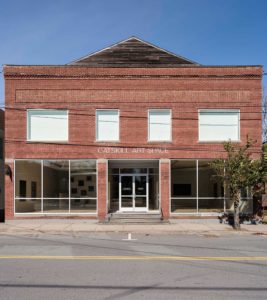
Designing Escape Country
Airbnbs, summer camps, and a brief history of paradise in the Catskills
The twelve-mile journey across the Hudson River Valley—from the village of Catskill, NY, to the foothills of the Catskill mountain range—lasted about five hours in 1826. Many took the first eight miles by coach, imbibing views of the rich woodlands and snug farmhouses depicted in Washington Irving’s “Rip Van Winkle” (1819). The last four miles were a trek, faster on foot than by carriage thanks to the road’s vertiginous incline. Guests of the Catskill Mountain House managed however they could, though, because awaiting them at the summit was a rarefied reception: buckets of champagne, a string quartet, and a brand-new, four-story neoclassical hotel perched on a ledge whose spectacular vista had recently entered the American imagination by way of James Fenimore Cooper’s blockbuster novel The Pioneers (1823).
The Catskill Mountain House was one of the first large-scale tourist properties to lure New Yorkers of means north, away from the grit and grime of a rapidly growing city, up to a wilder, grander scale of paradise. This vision attracted artists as well, notably members of the Hudson River School who sought to capture—and sell—the American wilderness on canvas. Their paintings tell tales of a rocky, precipitous environment tempered by bubbling brooks and verdant foliage, an American variation on the European sublime “man at edge of cliff, surveying other cliffs” landscape. Together with the era’s upstate literature, these works helped cement the Catskills’ reputation as one of the original idyllic American getaways.

From its affluent beginnings, the Catskills vacation was as much a psychic journey north as an upscale socioeconomic phenomenon. With the emergence of industrial wealth in New York came the desire and means to escape the crowded, polluted sources of that wealth. The Catskills catered to those desires. Accessible by boat up the Hudson River, they became the perfect getaway for morning hikes and roast-beef dinners, a kind of anti-New York for well-heeled New Yorkers who enjoyed their creature comforts.
These days, most people drive or train to the Catskills. But the region, in all its natural beauty, remains a thoroughly designed and marketed place—an escape country defined in our collective imagination by the distance between what we’re escaping to (hills, rocky cliffs, farms) and what we’re escaping from (high-rises, subways, smokestacks).
“It’s about a connection with nature. We love the city, but we know deep down that we need a connection with nature for our souls and minds. People just want to chill in nature and not work too hard at it”

“Opposed to the city’s population density, you have space to breathe; and with that, hiking and exploring and really enjoying the natural world—but also space to create new works.”
Since the nineteenth century, there’s been plenty of room for our imaginations, and the aesthetics, of the Catskills to shift. In the fifties and sixties, many saw summer resorts in the so-called Borscht Belt, a place for Jewish Americans to fashion their own “kingdoms of outdoor happiness,” as Grossinger’s put it. (Jewish families were often banned from exclusive resorts closer to the city.) The late sixties and seventies brought hippies seeking refuge from “the man,” carving out space for their own brands of communal living. After the Great Recession of 2008, the area’s rustic, blue-collar qualities took center stage. Many saw vintage pickup trucks and grain silos, semi-affordable lots on which to build a modest cabin and adorn it with decorative axes. Recently, in this era of precarious prosperity that’s deposited us on a ledge of financial inequality and class division, many tourists have been seeing, desiring, and manifesting something a bit fancier—an outdoorsy setting for their up-market tastes: trail-running, farm-to-table dinners, and luxury retreats with industrial-chic architecture and wooden-barrel saunas.
“For so long, there's been this nostalgia and romanticization of the Catskills of yesteryear, and this infatuation with the Borscht belt and the mid-century modern aesthetic. And recently there's been this Bohemian, luxe-country, rural look. It's all wrapped up in this nostalgia for a dressed-up rustic that is, like much of nostalgia, fabricated and made up. I'm interested to see where and how people push the envelope aesthetically.”
The next great aesthetic push may well come from a shift in home-buying tendencies. More people are now coming to the Catskills and staying, for good. Historically a getaway for tourists, retirees, and second-home buyers, the Catskills have begun attracting more full-time, working-age adults. The pandemic seems to have played a role, as has the advent of remote work. With better internet and video conferencing, more so-called “knowledge” workers and creative types can live and work in the sticks. Sally Wright believes this trend will fundamentally transform New Yorkers’ relationship with, and imagination of, the Catskills.
“The advent of remote work has allowed people to have a much more malleable work-life balance. And to that end, they're seeing the Catskills not only as a viable place to retreat and retire and escape from the busyness of our urban existences but also as a place that stimulates these points of desire and intrigue and curiosity that previously were specific to the city.”

“I do believe that a lot of the young families that moved to the Catskills because of the pandemic will stay. There are great restaurants and so many opportunities. You can have a full life and not feel isolated. You can feel a part of cutting-edge stuff. There is this critical mass of people doing and making. Places to eat and enjoy. Places like Kingston Standard and Phoenicia Diner. So much to do. It’s the critical piece: to have culture.”
The culture these full-time transplants are bringing to the Catskills is, of course, high culture, more affluent, artsy New York culture. And the result of their bringing it may be a breakdown in the town-and-country dichotomy that’s defined New Yorkers’ imagination of the Catskills for two centuries—since the age of James Fenimore Cooper’s The Pioneers and the ritzy, champagne-splashed Catskill Mountain House. Could this dynamic leave upstate design at an inflection point? Will the influx of full-time former urbanites continue unabated? Or is this just another mirage, a promise of worlds coming together, blue- and white-collar bipartisanship, high and low coexisting in positively purple counties, chatting contemporary art over homemade buffalo wings? Mirage or not, we hope this trend marks another new beginning for the Catskills as an ever-renewing conduit between contemporary city life and the natural world.

“It's great to see the breadth and diversity of people who come into our spaces. I’ll also say, as it relates to tourists, that I don't think all of the tourists or visitors that end up coming through our doors are necessarily interested in arts or visual culture; but much in the way many people interact and behave when they're on vacation, they just check out the local offerings. So that's also a really interesting point of exposure to a new audience.”